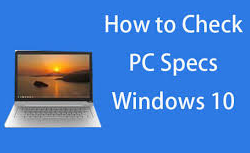Although most people today live their lives connected to the electronic gadgets of their choice. Hardware components are just a few people bothered to think about going to their smartphones, or gaming consoles. However, it is relatively easy to know the specifications of the phone and PC you use in your digital life. With that said, let us show you how to check the hardware specs and configuration of your Windows 11 PC.

Check Hardware Specs and Configuration of Windows 11 PC:-
There are many ways to check the hardware specifications of your Windows 11 PC. We will detail them all in today’s article. You can check your Windows 11 computer’s hardware space settings app, system information, DirectX diagnostic tools, command prompts, and numerous third-party applications. Let’s get started.
Steps to Check Hardware Spces of Windows 11 PC:-
As we mentioned above, there are several ways to check the hardware specifications of your Windows 11 computer. We will explain them all in this guide starting with the easiest way through Windows settings.
Methods1: Using the Setting Apps:-
The easiest way to find information about the hardware on your Windows PC is to use the Settings app. Here’s how you do it:
- Windows 11 Keyboard Shortcuts Open the settings panel using the Windows key. Now, go to ‘System -> About’.
- Under the Device Specification section, you can check the actual hardware location of your Windows 11 PC, which includes the processor, system memory, architecture, and more.
- Now, scroll down a bit in the Windows Specification section to check the information about your operating system. This includes version, version, date of installation, OS build, and service pack.
Methods2:System Information (msinfo3z):-
Another easy way to test the hardware specs of your Windows 11 PC is through the System Information Panel. Here’s how you do it:
- Open the Run dialog box by pressing the Windows key together. Then, type or copy + paste msinfo32 and press Enter.
- With the System Summary selected on the left sidebar, you can examine different aspects of your computer’s hardware. These include system model and type, processor brand and model, RAM capacity, motherboard brand and model, and virtualization support among other things.
Methods3: Direct X Diagnostics(dxdiag):-
Windows 11 also has DirectX Diagnostic Tools for viewing information about DirectX audio and video support. You can use it to check my system space. Here’s how:
- Open the Run dialog box described in Method 2. Now, type dxdiag and press Enter.
- Once on the DirectX Diagnostic page, click the Systems tab. Here, under System Information, you’ll find basic technical features, including processor, memory, system model and manufacturer, Windows 10 version, and more.
- Now, go to the Display tab at the top. Here, under the ‘Devices’ section, you can find out details about your GPU, including name and manufacturer, graphics memory, and display details.
Methods4: Command Prompt:-
At the command prompt, you can view the hardware space on your Windows 11 PC using the ‘System Information’ command-line tool. Here’s how it works
- First, open a command prompt window in admin mode. To do this, Search for ‘cmd’ in the Windows search bar and select Run as administrator.
- Now, type in the command prompt window or copy + paste system information and press enter. You will see detailed hardware and software information about the computer.
Methods5: PowerShell:-
You can use PowerShell to see the system specifications of your Windows 11 computer. To do this, follow the instructions below:
- First, open Windows PowerShell in admin mode on your PC. To do this, search for ‘PowerShell’ in the Windows search bar and click Run as administrator.
- In the PowerShell window, type Get-Computer Info and press Enter.
- To see the details of a specific element, use the following modified command: Computer – Get information – Property. Replace “property name” with the name of the element you want more information about. For example, to learn more about your Windows installation, use the following command.
Methods6:Device Manger:-
Alternatively, you can view system space on your Windows 11 PC through Device Manager. Here’s how you do it:
- Open the Run dialog box as explained earlier in the article. Then, type devmgmt. press Enter. The Device Manager window will now open.
- Device Manager displays a list of everything created on your PC, desktop. Go through each item in the list and check the names and model numbers of the hardware specs on your Windows 11 PC.
Methods7:Third-Party Applications:
In addition to the native methods mentioned above, there are a plethora of third-party applications that provide you with different levels of information about your system hardware. Some of the oldest and most accurate are listed below:
All of these tools are the latest open source, use or shareware free. You can use them to check information about your computer’s hardware. For demo purposes, we are using CPU-Z, which provides detailed information about the computer’s CPU, motherboard, RAM, GPU, etc. Open the program and navigate to the relevant tab to get all the details about the relevant components.
If you are a DIY type, the best way to collect all the details about your system hardware is to open the PC case. Once you open the computer, you’ll be able to physically inspect the individual components to learn more about your Windows 11 PC hardware.
Easily Check your Windows 11PC Hardware Configuration:-
As you can see, it is relatively easy to check the complete configuration of your PC. The best part is that there are multiple ways to do this and we have covered a lot in our article today. So now that you know how to view the hardware specs of your Windows 11 PC, check out some more guides that might work for you. These include how to keep your PC from overheating, how to improve the battery life of your Windows laptop, and how to change the power mode settings in Windows 11.